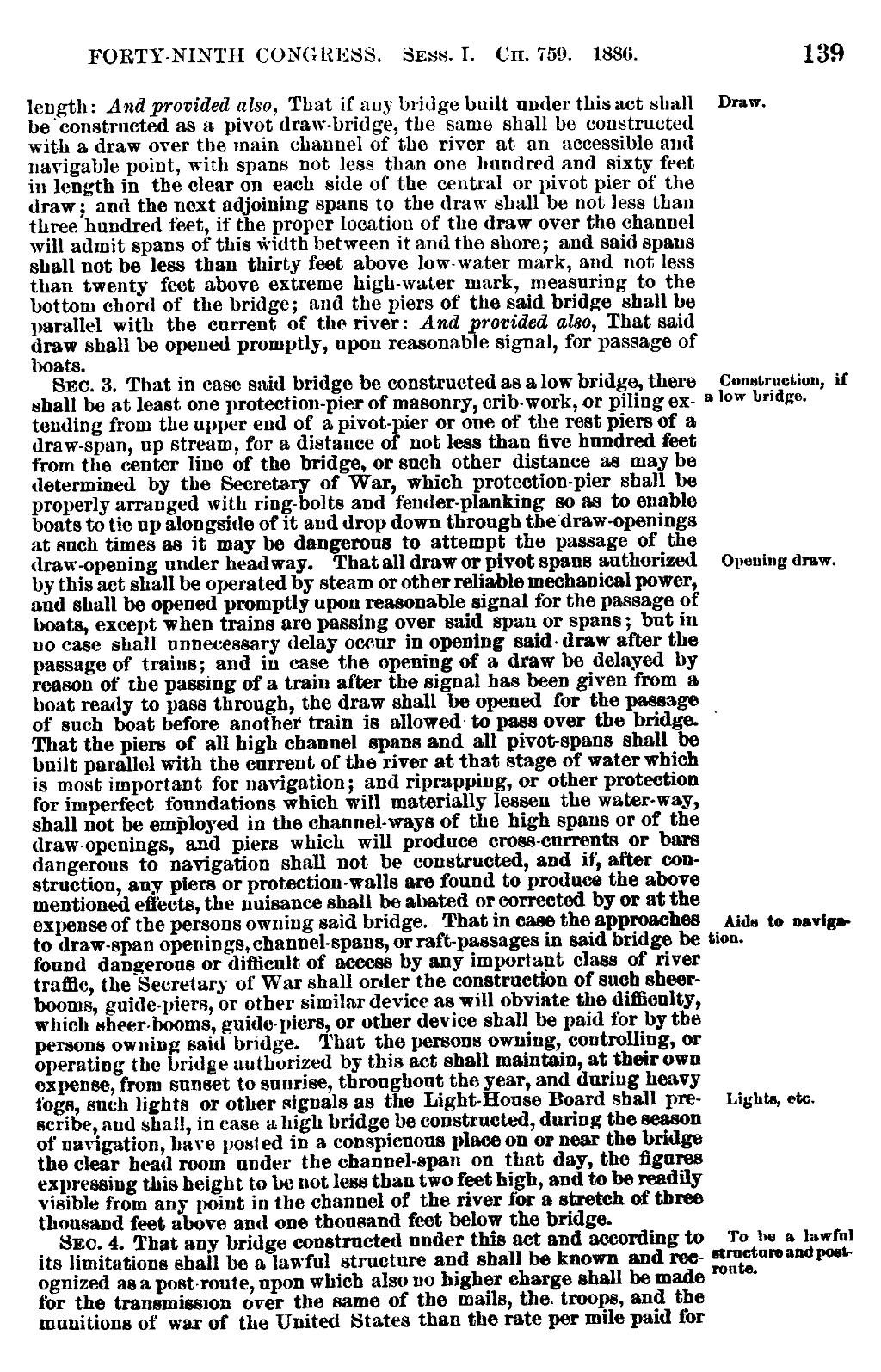FORTY-N IN TH UONG REBS. Sess. I. U11. 759. 1886. 139 length: And provided also, That if any bridge built under this not shall Draw. beconstructed as ai pivot dra.w—bridge, the same shall be constructed with a. draw over the main channel of the river at on accessible and navigable point, with spans not less than one hundred and sixty feet in length in the clear on each side of the central or pivot pier of the draw; and the next adjoining spans to the draw shall be not less than three hundred feet, if the proper location of the draw over the channel will admit spans of this width between it and the shore; and said spans shall not bs less than thirty feet above low-water mark, and not less than twenty feet above extreme high-water mark, measuring to the bottom chord of the bridge; and the piers of the said bridge shall be parallel with the current of the river: And provided also, That said draw shall be opened promptly, upon reasonable signal, for passage of boats. Sec. 3. That in case said bridge be constructed as alow bridge, there Constr uct.ion, it shall be at least one protection-pier of masonry, crib-work, or piling ex- ° ‘°“' b¤d¤°· tending from the upper end of a. pivot-pier or one of the rest piers of a. draw-span, up stream, for a. distance of not less than five hundred feet from the center line of the bridge, or such other distance as may be determined by the Secretary of War, which protection-pier shall be properly arranged with ring-bolts and fender-planking so as to enable boats to tie up alongside of it and drop down through the‘dra.w-openings at such times as it may be dangerous to attempt the passage of the draw-opening under headway. That all draw or pivot spans authorized Opening draw. by this act shall be operated by steam or other reliable mechanical power, and shall be opened promptly upon reasonable signal for the passage of boats, except when trains are passing over said span or spans; but in no case shall unnecessary delay occur in opening said- draw after the passage of trains; and in case the opening of a. draw be delayed by reason of the passing of a. train after the signal has been given from a boat ready to pass through, the draw shall be opened for the passage of such boat; before another train is allowed- to pass over the bridge. ` That the piers of all high channel spans and all pivot-spans shall be built parallel with the current of the river at that stage of water which is most important for navigation; and riprapping, or other protection for imperfect foundations which will materially lessen the wa.te1··way, shall not be employed in the channel-ways of the high spans or of the draw-openings, and piers which will produce cross-currents or bars dangerous to navigation shall not be constructed, and if', after construction, any piers or protection-walls are found to produce the above mentioned effects, the nuisance shall be abated or corrected by or at the expense of the persons owning said bridge. That in case the approaches Am., gs ,.,,5;.. to elrawspan openings,channel·spuns, or raft-passages in said bridge be tion. found dangerous or difficult of access by any important class of river tratiic, the Secretary of War shall order the construction of such sheerbooms, guidc-piers, or other similar device as will obviate the eliiiiculty, which sheer-booms, guido-piers, or other device shall be paid for by the persons owning said bridge. That the persons owning, controlling, or operating the bridge uuthorized by this not shall maintain, at their own expense, from sunset to sunrise, throughout the year, and during heavy logs, such lights or other signals as the Light¤House Board shall pre- Lights, sw. scribe, und shall, in case ei high bridge be constructed, during the season of navigation, have posted in a conspicuous place on or near the bridge the clear head room under the channel-span on that day, the iiguros expressing this height to be not less than two feet high, and to be readily visible from any point in the channel of the river for a stretch of three thousand feet nbovo undone thousand feet below the bridge. Sec. 4. That any bridge constructed under this act and according to To be a lawful its limitations shall be a. lawful structure and shall be known and rec- ¤mt<;*“¤°¤dP°°* cguizcd asapost-route, upon which also no higher charge shall be made r°" ‘ for the transmission over the same of the mails, the. troops, and the munitions of war of the United States than the rate per mile paid for
